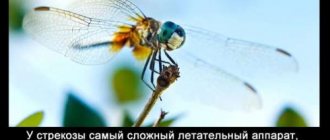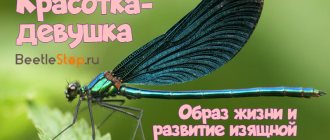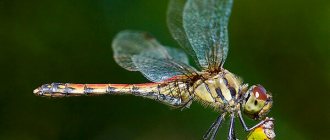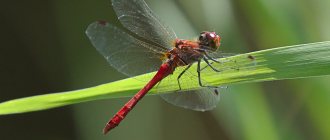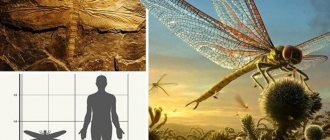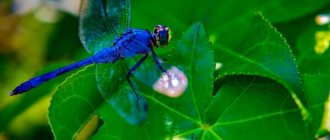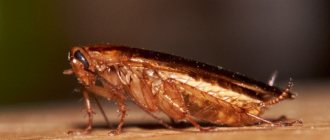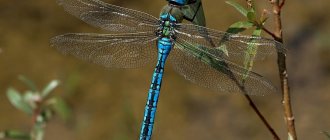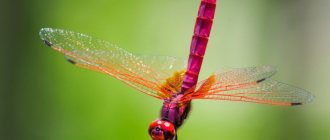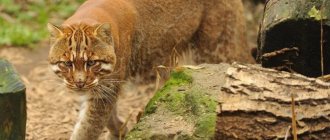Dragonflies
» Arthropods » Dragonflies
Superclass: Insects (Insecta)Class: Open-jawed (Ectognatha)Order: Dragonflies (Odonata)
Dragonflies are the fastest flying insects in the world. At short distances, their flight speed can exceed 100 km/h. These predatory insects are extremely voracious - in a day they eat a volume of food many times greater than their own weight. The unique huge eyes of dragonflies consist of 20-30 thousand ocelli, or facets, and provide the insects with almost complete all-round visibility.
Currently, about 5,000 species of dragonflies are known. They live mainly in the tropics and subtropics. About 170 species are known in Russia. The problem of flutter - vibration of wings in flight, which at the dawn of aviation caused the death of more than one aircraft, was solved by dragonflies millions of years ago. A slight thickening of the wing, called the pterostigma or “marginal eye,” reliably eliminates all unwanted wing vibrations.
| Brilliant beauty |
Adult dragonflies are graceful and fairly large insects with a spindle-shaped, often brightly colored body, a large rounded head and long mesh wings. They can move independently of each other and significantly increase their flight speed. The long and light abdomen serves as a rudder for the dragonfly - it helps to maintain direction. The legs of dragonflies are poorly developed and are not adapted for walking.
Dragonflies are active predators and prefer open spaces. They catch their prey - flies, mosquitoes, midges, sawflies - and eat them in flight, tearing them apart with sharp mandibles. Dragonflies are most active during the day, during the hottest hours; in good weather, flight begins after sunrise and ends at sunset. Most often they can be found along the banks of reservoirs, forest edges, along forest roads and clearings. After mating, which occurs in the air, the fertilized female lays eggs either directly into the water or into underwater or above-water parts of plants. The eggs hatch into larvae that develop mostly in shallow bodies of water.
| Structure of a dragonfly |
The larvae are completely different from adults, but also lead a predatory lifestyle, feeding on aquatic invertebrates, tadpoles and even fish fry. In larvae, the lower lip is transformed into a kind of hunting organ - a mask with hooks. Approaching the victim, the larva folds its mask forward, and the hooks dig into the victim. The larvae are unusually voracious predators - they eat aquatic invertebrates, and large larvae even attack tadpoles and fish fry. The development of a dragonfly larva lasts 1–3 years, sometimes longer. Before flying, it rises from the water along the stems of plants and is gradually freed from the skin. First, young adult dragonflies dry their delicate wings in the sun and then take to the air.
Dragonflies are a good indicator of the cleanliness of water bodies. They cannot thrive in polluted water, and therefore you will rarely see them on the banks of urban rivers. Dragonflies are grouped into two large groups: homoptera and heteroptera. Among the small-sized and graceful homoptera dragonflies, the most famous are representatives of the families Krasotki with blue or green wings, Lyutki, and Strelka. The span of large heteropterous dragonflies can reach 10–12 cm; these are species of the families Rocker, Dedki, Grandmothers, Watchers, and True dragonflies.
| In some eastern countries, larvae and adults of dragonflies are quite a common dish. Don’t be surprised if you are lucky enough to find a similar treat at one of the local markets |
Interesting fact
Despite the fact that dragonflies are formidable predators, they themselves are often prey to large animals such as frogs, lizards and birds. For the latter, such a diet is fraught with considerable danger: after all, dragonflies act as carriers of a parasitic disease - prostagonymosis. Its causative agents are flatworms, which, when ingested by a bird, make it incapable of laying and incubating eggs: the shell becomes too fragile or does not develop at all.
Graceful hunter - dragonfly
These are the largest flying insects. All of them are divided into heteroptera and homoptera. Different-winged dragonflies are larger in size than even-winged dragonflies, and besides, they fly better.
The insect's body consists of a head, chest and long abdomen, at the end of which there is a pair of forceps. Body length 3 - 12 cm. Color varied: white and green, yellow and red, blue and orange.
Graceful transparent wings are its decoration. There are many transverse and longitudinal veins on the wings, which have a strengthening function. A dark spot on the wing protects the fly from vibration in flight.
Agile flyers develop colossal speed; some species can cover distances at speeds of 100 km/h.
Basically, the flight speed of the “jumper” is 5 km/h. They cover hundreds of kilometers without stopping, and can expertly hover in the air and suddenly stop. When she sits on a branch or any solid ground, her wings do not fold, they are always in a straightened state.
Each individual has three pairs of legs covered with shields. In flight, they fold their limbs into a basket - this makes it more convenient to grab prey.
Their mouthparts are of the gnawing type. The lower lip is a harpoon, shoots and grabs prey. Large eyes help track prey and can see anything edible at a distance of 10 meters. The structure of the eyes is complex - faceted.
All dragonflies are predators. They feed mainly on mosquitoes, flies, moths and other insects, which they pursue with great speed.
Dragonflies live in Europe, Asia, America, Australia, and Africa.
They can be found in meadows, forest edges, fields, but there must be a body of water nearby. They lead a solitary lifestyle. Enemies - many birds, spiders.
The larvae are inactive and spend their development in the fresh waters of the reservoir. In some species, development can last 5 years. Larvae with huge eyes They are ferocious and voracious predators, they can even eat their relatives.
They wait for hours for their prey to hide, and as soon as it appears in sight, they immediately attack it. They feed on aquatic insects and their larvae and fry. Having lived in the reservoir for the required period of time and shed several times, the naiads climb out of the water along the stems of aquatic plants.
Having dried, they molt for the last time, and a beauty with wings is born. A few more moments and she will fly into the sky.
Despite their predatory lifestyle, insect larvae are often easy prey for other natural inhabitants, such as fish. Out of one hundred eggs, only three individuals survive to the adult stage. Adults live for about a month and then die.
In the wild, dragonflies live for 7 years.
The fauna that surrounds humans is rich and diverse. Knowledge about some creatures will help us understand and realize what is around each of us. This article discusses orders of insects: dragonflies, lice, beetles, bedbugs, which are most often encountered in people's lives.
Dragonfly lifestyle
The detachment is distinguished by an extraordinary way of life, in comparison with other representatives of the class Insects
Winged predators attract attention from the moment they transform into a naiad, which shocks with its gluttony and the duration of its stay in this transitional stage for the insect. Having transformed into an adult, dragonflies acquire the skills of a special flight style
How long do dragonflies live?
Its short lifespan, only 3-5 months, obviously presupposes a very active lifestyle. Dragonflies are diurnal, solitary insects that move and hunt in the sun. At night, in inclement weather, they hide in shelters. They also go there for the winter.
After hatching from an egg in the form of a larva, the insect lives in the water column for up to 5 years and molts more than 10 times. If the dragonfly is not eaten during this time, the larva grows wings and crawls onto the above-water stem of some plant, where a real dragonfly hatches. She spreads her wings, takes flight, and becomes an adult.
In autumn, the majority of dragonflies die. In the spring, new larvae, naiads, hatch from the eggs. The circle of life of this amazing insect begins again.
Hunting
You shouldn’t be fooled by its carefree, graceful flight: behind the chirping and bright colors hides a cruel winged predator. Endowed with the body of an ideal flying hunter, he orients himself in space almost unerringly. When hunting in flight, dragonflies attack their prey from below. This is due to the special structure of vision, which opens up a better view against the backdrop of a clear sky. Insects intercept by calculating almost 100% of the victim's trajectory. It is calculated by reading information with all eyes.
Having caught prey, the insect fixes it with its front legs, depriving it of the chance to make any movement. Then, with the middle pair of legs, it tears off the wings. Having lost hope of salvation, the victim is practically crushed by powerful serrated jaws to a mushy state and sent off for further digestion.
Having swallowed the prey, the predator again begins active hunting.
The main danger to dragonflies is birds, some types of fish, and large spiders that can cause harm. However, dragonflies, as typical predators, defend themselves to the last: they bite and sting.
Reproduction
When it’s time to reproduce, males unite in large flocks and fly around areas close to water bodies in search of a mate. During fertilization, the male grabs the female's head with his claws and holds her firmly in place. Afterwards, the fertilized female goes to the water and lays eggs on underwater and above-water plants. The number of eggs at a time can exceed 600 eggs from one female.
During development, the dragonfly goes through an incomplete cycle. The path from egg to adult is carried out without transformation into a pupa. A larva called a naiad emerges from the egg within 15 to 35 days. It continues its development under the water column, moves slowly in search of food, and in case of danger, uses the force of pushing air out of the anus, developing high speed for the sake of salvation. Feeding lasts as long as food is freely available to the larva.
In the described stage, a dragonfly can survive up to five years, regularly shedding its old, tight skin. The number of molts exceeds 12-15 times. The final stage occurs on land, where the insect is ready for the first flap of its newly spread wing, its first adult flight.
Dragonfly paradise
You will need
- old carpet;
- waterproofing for ponds;
- watering hose;
- shovels for digging a pond;
- various moisture-loving plants.
Choose a sunny and calm place. Dig a hole one to five square meters in size, one meter deep. Near the coast, make a gradual descent, arranging an area for plants at a depth of 50 centimeters.
Line the hole with sand and old carpet. Apply waterproofing, digging it around the edges. Line the edges with rocks and slowly fill the pond with water using a hose. Let it sit for a few days.
Tidy up the banks of your dragonfly pond by lining them with pieces of turf. If you have a pond in the middle of your lawn, you can use the turf you removed when digging the hole. You can also use small stones and boulders.
Your pond is now almost ready. It remains to think which inhabitants will become the best neighbors for the beautiful dragonflies.
Dragonflies need four types of plants: underwater plants to provide oxygen, floating plants to provide shelter for the developing naiads, long-stemmed shoreline plants where dragonflies will emerge from their larvae, and wildflowers in close proximity to the pond to attract small midges and mosquitoes. , serving as food for dragonflies.
Nutrition
Our next question is the internal structure of the dragonfly and nutrition. As mentioned earlier, the dragonfly is a phylum of arthropods. We know that in representatives of this type the circulatory system is not closed, the heart looks like a multi-chambered vessel. The brain and ventral nerve cord represent the nervous system of insects.
What can a developed gnawing mouthpart, well-developed vision, an elongated body and large, rather powerful wings indicate? Of course, dragonflies are predators. They prefer to eat their prey on the fly. They feed on insects, usually harmful ones. They catch large ones with their paws, and catch small ones (midges, mosquitoes) directly with their jaws. To taste large prey, the dragonfly has to descend to the ground. Hunting is a real spectacle. Even such good and nimble flyers as flies do not escape the clutches of dragonflies
It is important to know that representatives of dragonflies are very voracious. During the day, they eat prey several times their weight (for example, they can destroy more than forty flies in a day)
Interesting fact
In the Japanese city of Nakamura, the world's first natural dragonfly park, called “Dragonfly Kingdom,” was built in 1988. Here you can observe more than sixty species of them. The entire design in the park is dedicated to these insects. In addition, here you can see paintings with dragonflies, a large collection, taste tea from cups with images of dragonflies and buy books on the “dragonfly” theme.
Lifestyle
Dragonflies are diurnal predators and are active in warm, sunny weather. Night time and inclement weather are experienced in shelter. In the morning hours, adults gain energy by basking in the sun. They land on tree bark, branches, and grass stems. In hot weather, they point the tip of their abdomen upward, reducing the area of sun exposure. Adults have excellent vision. They notice prey at a great distance and successfully attack.
Insects have no food preferences; they hunt any objects of suitable size. Varied-winged predators easily maneuver and dive, can make high-speed flights and move a considerable distance from the place of birth. Mass migration of the common dragonfly is observed in July-September. The emergence of adults after molting occurs gradually, so individual individuals can be found even in October.
Despite its reputation as a ruthless predator, the dragonfly itself often becomes prey. It is hunted by birds, reptiles, and mammals. Insects that land on the water are attacked by fish. Cannibalism flourishes among representatives of the order Odonata; large individuals catch and eat smaller ones. Swimming beetles and water bugs pose a danger to the larvae. How long does the common dragonfly live? This species spends several months at the adult stage. The larva develops for about 1 year.
Habitat
The common dragonfly is a transpalearctic species. Insects live in large numbers in Europe, Central Asia, Siberia, the Far East and northern Africa. They settle near lakes, swamps, and reclamation canals. They prefer ponds abundantly overgrown with vegetation.
Features and habitat of the dragonfly
Description of dragonfly
It’s worth starting with the eyes of this insect, which at first glance seem disproportionate and too large relative to the overall size of the body.
However, dragonflies have so-called facet vision, which is due to the presence of several tens of thousands of small eyes, each of which works independently and is separated from the others by special pigment cells.
The structure of the dragonfly's eyes allows it to see even what is happening behind
Thanks to this strange eye structure, the dragonfly's vision is much better than many other insects and allows it to see everything that is happening behind, on the sides and in front and track prey at a distance of up to ten meters.
The dragonfly's body consists directly of the head, chest and long belly, which ends in a pair of special forceps.
The length of the insect ranges from 3 to 14 centimeters. Coloration is quite varied and can vary from white, yellow and orange to red, blue and green.
The wings have many transverse and longitudinal veins, which serve as reinforcements.
Insect dragonfly - animal
, which is one of the record holders for the speed of movement: although its average flight speed is usually from 5 to 10 km/h, some varieties are capable of reaching speeds of up to one hundred km/h when flying over long distances.
So, despite the image of an idly staggering jumping dragonfly
, created in one famous fable, this insect is very mobile and leads an active lifestyle.
Dragonflies have three pairs of legs, which are covered with a layer of protective bristles. During flight, the limbs of the insect fold into a “basket” in order to quickly grab prey if it is detected. The wings have dark spots that serve as vibration protection.
It is worth noting that the first jet aircraft took off due to the fact that entomologists shared with designers and engineers this structural feature of the wings of dragonflies, who used this element in the structure of aircraft, which would still crumble as soon as they left the surface of the earth, if would not be dragonflies.
The habitat of dragonflies is very extensive and extends from the territory of modern Europe and Asia to the African continent, Australia and America.
Dragonflies live
mainly among meadows, fields and on the edges of forests. A prerequisite must be the presence of a body of water nearby.
The most dexterous and fastest
It’s not just the dragonfly’s eye that’s amazing about this insect. The wings alone are worth it! They have small spots-thickenings, which are called wing eyes. Aviation designers also came up with similar designs for airplanes. This detail helps prevent the wings from oscillating and breaking during flight. By the way, the dragonfly flies at an amazing speed - up to 100 km/h.
And dragonfly larvae, which live in bodies of water, are the most unusual inhabitants of ponds and ditches. Their correct name is nymphs. They live a long time. They spend 2 years in a pond. But the adult individuals themselves, whose correct name is imago, live 2 times less. This period is only 10 months, unless they die earlier. Nymph-larvae, while in the water, molt 10 times and grow up to 4-5 centimeters in length, becoming almost the largest insects among their neighbors in the pond. The larva moves like a squid, using a special bag into which it sucks water and then pushes it out with force, like a jet engine. The way the larva catches food, using its lower lip, is also unusual. When at rest, this organ is folded and placed on the front of the head. Its correct name is “mask”. But when a tadpole or some kind of beetle swims by, the lip unfolds and, with the help of two hooks located at its end, catches the prey and brings it to the mouth.
The dragonfly is an amazing representative of the insect world. This is a beautiful, fast and unusual assistant to humans in protecting plants from pests. Yes, dragonflies destroy several tens of thousands of insects, most of them harmful to plants, during their rather short life. And they deserve respect and attention from people.
The fauna that surrounds humans is rich and diverse. Knowledge about some creatures will help us understand and realize what is around each of us. This article discusses orders of insects: dragonflies, lice, beetles, bedbugs, which are most often encountered in people's lives.
General characteristics help to understand what each unit is. Dragonflies are the largest flying insects on Earth. They are predators. The order of dragonflies includes suborders: heteroptera and homoptera.
Today, more than 6 thousand species of dragonflies are known. They are distinguished by their color, which can be very different, and their size, which can be from 3 to 12 centimeters. There are several thousand species of lice.
But among this huge variety of lice, only three types are dangerous for humans: head, body and pubic. They differ in their habitat.
The entire variety of beetles can be divided into 6 families: predators, weevils, longhorned beetles, leaf beetles, ground beetles and lamellar beetles. The variety of bedbugs is very large. The most famous of them are those that feed on human blood.
How many eyes does a dragonfly have?
In appearance, this insect has only 2 huge round eyes. But in fact this is a completely wrong idea. After all, a dragonfly is amazing - it consists of several tens of thousands of small eyes, there are up to 30 thousand of them. Or rather, it would be correct to call them facets. They are very, very small and set so close to each other that they seem like one huge eye. But the facets look separate from each other. It turns out to be a huge overview in all directions, although each facet sees just a little.
The dragonfly's vision range is small - only about 8 meters. But that's enough for her. The triple eye of a dragonfly is surprising not only in the number of facets that make it up. These organs of vision have a cone-shaped shape: the wide part is the visible surface, and the narrow edge brings together all the facets into one whole in the depths of the eye. Unlike a person, who, thanks to the lens, sees the image upside down, and then the brain processes the information as expected, the dragonfly initially sees the image upright.
Character and lifestyle of the dragonfly
Dragonflies lead a solitary lifestyle, preferring to hunt on their own. Thanks to its specific wing structure, a dragonfly can either hover in the air, making an instant stop, or fly over vast distances, covering several hundred kilometers without rest.
During landing, the dragonfly does not fold its wings, like many other insects, but always leaves them in a straightened state.
The main peak of activity occurs during daylight hours, during which dragonflies fly in search of prey.
During hot hours, they can be observed in huge numbers along the banks of reservoirs and above forest edges.
The flight of a dragonfly is characterized by noiselessness, thanks to which the dragonfly can unnoticed approach its prey.
They can make intricate turns in the air, do somersaults and even fly backwards. Thanks to this ability, dragonflies can easily escape from predators pursuing them.
Where do dragonflies live?
The habitat of dragonflies is very extensive. They can be found in any region of the world where the weather is warm, there is water and a large supply of food. These insects are widespread in Russia and Belarus, Germany and France, Italy and Spain, and the countries of the Balkan Peninsula. Many species of dragonflies live in the Asian region: India and Pakistan, Thailand and Azerbaijan, Armenia and Iran, Turkey and China. The dragonfly also lives in the vastness of the African continent, Australia, North and South America. The dragonfly is an insect that prefers a solitary lifestyle. It is active during the daytime, preferring sunny hours, and waits out unfavorable cloudy weather in shelters. Natural enemies of dragonflies include many species of birds, fish and spiders.
Arrows
Arrows are not as spectacular as beauties, but just as graceful dragonflies. The photo of the graceful arrow, posted below, confirms this fact.
Shooters lead the same lifestyle as beauties, except that they choose more modest prey.
And it is not surprising, because the body length of the graceful arrow is only 3.5 cm, while the wingspan is 4.5 cm. The male has an elongated blue chest with a longitudinal black stripe and a black abdomen, as if intercepted by thin blue rings. The wings are narrow and transparent. Some females have a similar coloration, others are rather inexpressively colored and have neither stripes nor rings.
Arrows fly slowly and rarely leave their homes. Their larvae live and hunt in the stems and roots of aquatic plants. Distinguishing one species from another within this family is not an easy task. But it is impossible to confuse them with another family of arrows.
Insect lifestyle
Dragonflies are agile predators; their diet consists of small insects and invertebrates. They grab and eat prey on the fly. Adults are diurnal; they are most active on a clear sunny day. They spend the night sitting on bushes or tall grass. Summer period is from April to October. Females usually settle in forest clearings and fly to the banks of reservoirs to mate and lay eggs. Males choose coastal areas for themselves, where they live, hunt and wait for a partner for procreation.
The life of a beautiful girl dragonfly can be divided into two periods:
- Juvenile - begins after the imago emerges from the larval shell. It lasts about 10 days. The dragonfly actively feeds away from the reservoir until it acquires a characteristic color.
- Reproductive - having reached sexual maturity, insects return to water. Mating and egg laying occurs.
Dragonflies are insects with incomplete metamorphosis; their life cycle has three stages: egg, nymph, adult. Most of their life is spent in water - 2-3 years. The adult phase is much shorter - several months. Dragonflies are very shy; they fly into the air at the slightest noise or vibration in the air. Quick reaction saves insects from birds, amphibians and other enemies.
Nymph - predator in a pond
Dragonfly larvae are called nymphs; in appearance they differ significantly from adults. This is due to being in a different environment. Nymphs of beautiful girls prefer cool ponds with running water. Their body is elongated, brown in color, and their limbs are striped. Small predators eat fish eggs, mayfly larvae, mosquitoes, and small invertebrates. Nymphs are sensitive to water pollution; they survive only in clean water bodies. This is a kind of safety marker for a river or stream. In many countries of Central Europe, insects are listed in the Red Book. The lack of clean water bodies has threatened the existence of beautiful girls in Germany, Austria, and Switzerland.
Lute-bride (Lestes sponsa Hans.)
The length of the abdomen is 25-33 mm, the length of the wing is 19-24 mm. It is distinguished by sexual dimorphism in coloration. Males are completely metallic green, becoming covered in places with a blue waxy coating as they age; females have green spots on a yellow background. The species is distributed throughout Russia, with the exception of the far north of Siberia. Very common throughout the European part of the country. Male dragonflies have been shown to exhibit territorial behavior during the breeding season, similar to that of many true dragonflies and dragonflies. They also fly to the same place in the morning, guard it, and leave in the evening. The summer period of adult dragonflies is from June to September. The larvae live in shallow stagnant bodies of water. The eggs survive temporary drying out of water bodies very well. Full development of the larvae lasts about a year.
What does a dragonfly eat?
Dragonfly with prey
Dragonflies are predators, so they feed on most airborne insects. Their diet mainly consists of midges, mosquitoes, various flies, and arthropods. In the larval stage they eat small fish or their own kind.
Subspecies are divided according to hunting method:
- Free hunters fly high. They have strong, developed wings that allow them to maneuver on the upper tiers. Sometimes they hunt in a flock, but most often they hunt completely alone, flying at a distance of two to nine meters.
- Free flying, hunting in the territory of the middle tier. They do not fly over the two-meter high line. They constantly look for food, sometimes resting on plants.
- Lying in wait - they hunt from ambush, waiting for prey.
- Dragonflies also live in the lower tier. They hunt in grass thickets, catching insects on plants. They feed while sitting on the grass, not in flight.
Benefits and harms
The benefit is that adult dragonflies eat annoying and harmful insects (mosquitoes, flies and others), their larvae destroy mosquito larvae. However, dragonflies spread a dangerous disease of birds - protogonimiasis. The larvae of some representatives are capable of eating fry in fisheries.
how many eyes does a dragonfly have?!
A dragonfly has two big eyes...
With no hearing and limited sense of smell, the dragonfly's most important advantage is its eyes. Dragonflies are thought to have the most complex eye structure of any insect, giving them an incredible advantage when hunting. Adults, with a nearly 360-degree field of vision and an extremely mobile head, can see in almost all directions except “straight back.”
The eyes of these insects consist of 30,000 hexagonal facets that receive information from different areas of space, as a result, the vision of the world is composed of many local images like a mosaic. For various reasons, dragonfly vision has become more advanced than human vision. Humans have three opsins (light-sensitive proteins in the retina), each of which absorbs a specific color in the spectrum, such as red, green or blue.
Dragonflies have up to 5 opsins, allowing them to see ultraviolet light in addition to a wide range of colors. Their eyes are also able to detect the polarization of light and clearly distinguish rapidly changing images. Dragonflies can detect rapid flashes of light up to 80 times per second—twice as fast as the human eye can detect—which helps them recognize patterns in their rapidly fluttering wings. The largest of the many dark spots on a dragonfly's eyes is where dense clusters of facets form a fovea that provides minimal blurring during flight at high speeds. A larger spot indicates improved vision in that direction. In day-hunting dragonflies, they are located in the upper part of the eyes and contain facets that most acutely perceive blue and ultraviolet light. Due to this feature, the sky appears brighter than the ground - an optical effect that allows the dragonfly to easily find prey against a bright background and attack it from below.
QUOTES from some articles:
“...When examining a dragonfly, attention is drawn to its huge eyes, which occupy most of the head. The eye consists of 28 thousand facets (ommatids), each of which is served by 6 light-sensitive cells. A dragonfly can spot a mosquito at a distance of up to 10 meters
By eating mosquitoes, horseflies and other bloodsuckers, dragonflies bring great benefits..."
“...Insects have so-called facet vision,” explains Ms. Chubarova. “The eye is made up of thousands of tiny facets, and the information coming from all the facets is combined into an overall picture. For example, the eye of a dragonfly consists of 28,000 “ocelli”
…»
“...in many ways, dragonflies are even more perfect than humans. At least their adaptation mechanism, which allowed them to exist for so long and practically in the same appearance in a changing biosphere. Or the structure of the dragonfly's eye, which provides it with a spherical view - it simultaneously sees what is happening in front, behind, below, above, and from any side. By the way, in those days, this ability was described in a scientific article by one scientist from Tomsk University in the journal Physiology. And after that he had a long conversation with the KGB, since he described with one-to-one accuracy the principle of operation and even the formula of the equipment then in service in the air defense, anti-missile forces. Thank God it worked out..."
Distribution and migrations
It is found on all continents (a rare species in Europe), except Antarctica. Numerous observations and captures of individuals have shown that the species is distributed over a very wide region, between the 40th parallel or within the region with an isotherm of 20 °C (that is, where the average annual temperature is above twenty degrees Celsius), and in North America up to 50th parallel. In Europe there are only isolated occasional records of the species, mainly in the Mediterranean region. All occurrences of the red tramp in Great Britain and France are associated with commerce and transportation along with fruit and other similar goods. An explanation for the rarity of the species in Europe is the barrier effect of the Sahara, which generates unfavorable winds such as the Sirocco, whose dryness makes the passage of dragonflies almost impossible.
Their flights in the subtropics and tropics coincide with the intertropical convergence zone. Evidence of their preference for moist winds is that these dragonflies migrate to Tamil Nadu in Southeast India only after the second monsoon, which brings rain to the region. However, in the rest of India, the red-headed stray appears with the first rainy monsoon. Observations and data obtained using stable isotopes indicate that they migrate from India and onwards through ocean islands to Africa via the Arabian Sea. Dragonfly migrations in India begin in September, in the Maldives they first appear in October, in the Seychelles in November (4° S, 2700 km from India) and on Aldabra Atoll (9° S, 3800 km from India) in December, after which they fly to East Africa. Taking into account return migration, the total route of migrants (possibly up to 4 generations) is 14,000–18,000 km (for an individual up to 6,000 km).
The highest flying species of dragonfly, recorded in the Himalayas at an altitude of 6200 m. It is also the first species of dragonfly to colonize Bikini Atoll after nuclear explosions were carried out on it (from 1946 to 1958). It is also the only species of dragonfly found on Easter Island. Presumably, in cold parts of its range, for example, in southern Canada and South Australia, this species does not overwinter, but there is further annual recruitment by migrating generations from other regions.
According to recent research conducted by biologists from Rutgers University-Newark, this species of dragonfly is considered the longest known traveler in the world. Genetic data taken from dragonflies around the globe suggests that these small insects travel long distances to mate and thus create a global gene pool. Another study concluded that the red tramp as a species represents an almost global single panmictic population in which an equilibrium distribution of frequencies of genotypic classes of different individuals is achieved.
The species is known for its penchant for long-distance flights and migrations, which is reflected in the morphology of the species - they have one of the largest relative area and length of wings among heteroptera dragonflies. In addition, this species is characterized by the ability to develop in small temporary reservoirs. With the help of these adaptations, every year during the warm season, adults migrate from the main part of their range to much more northern latitudes, where they reproduce, but are not able to survive the winter (and freeze out, for example, in Japan). Some representatives of this species are also found in more northern regions, for example, in Transbaikalia and Kamchatka.
What do dragonflies eat?
By the nature of their feeding, dragonflies are typical predators that catch their prey on the fly. Each individual has its own hunting grounds, which they zealously defend from strangers and, if necessary, fight for them. The main food of dragonflies is flies, mosquitoes, moths and other small flying insects. Large individuals are capable of eating small fish, spiders and frogs.
Dragonfly larvae (naiads) feed on young fish, small aquatic insects, crustaceans, and larvae of flies and mosquitoes. This diet is determined by the aquatic habitat. In addition, they clean the reservoir from decaying remains of animal and plant origin.
Reproduction and development of dragonflies. How is a dragonfly born?
During the mating season, male dragonflies gather in huge flocks and patrol areas located near water bodies.
After fertilization, the female dragonfly flies to a pond and leaves eggs directly in the water, placing them inside underwater or above-water parts of plants. The number of dragonfly eggs can reach 600 pieces.
How dragonflies lay eggs
Dragonfly eggs
The development cycle of dragonflies is incomplete. The transformation into a mature individual occurs without the pupation stage. The egg stage period lasts from 14 to 35 days. After which, a naiad larva emerges from the dragonfly egg and continues to develop under water. The dragonfly naiad breathes using peculiar gills located in the hindgut. To supply the body with oxygen, the larvae constantly suck water into it through the anus. They push the “waste” liquid out with force and thus move using the principle of a jet engine.
During the larval stage, the molting process occurs up to 15 times. As the dragonfly larva grows, it begins to grow wings, which are still fragile when the insect emerges into the air. The last change of “skin” occurs on land, and an hour later the dragonfly is ready for its first flight. The dragonfly larval stage, depending on the species, can last up to 3 years.
Form and structure
The female dragonfly lays eggs in water, attaching them to a variety of plants, silt or moss. After 14-35 days, arachnid pre-larvae hatch from them (less than 1 mm), immediately molt, then move to the next stage and continue their development in the water element. Oddly enough, the dragonfly larva is called a nymph, or a naiad. Whoever came up with this clearly had a good sense of humor.
The respiratory system and oral apparatus of a nymph are radically different from that of an adult. This is due to the aquatic lifestyle. The naiad breathes through gills, a kind of organ located in the hindgut. Oxygen enters through the anus along with water. The larva sucks it in like a powerful vacuum cleaner.
The “spent fuel” is thrown out with force, like a jet stream, and pushes the naiad forward. This is how she moves.
Appearance of a naiad
The dragonfly larva looks like a caricature of a cockroach drawn by different artists. Depending on the species and group to which the adult belongs, the body of the nymph can have a different shape. For some it is thick and short, for others it is more elongated and slender. In its front part there are three pairs of legs. In relation to the body, they are longer than those of an adult dragonfly. An interesting feature is that in the early stages of its development, a naiad can regrow a severed leg.
Body color varies in olive-brown tones.
On the sedentary head of the nymph, huge compound eyes stand out on the sides, and a well-developed jaw, which is equipped with a special organ called a “mask”. This is an overgrown lower lip that performs a grasping function during hunting. The mask has:
- two chins;
- distal blade;
- labial palps-lobes.
It can extend forward and fold back.
As the naiad develops, it becomes more and more like an adult, but before becoming a dragonfly, it needs to molt 7 to 11 times or more.
These insects undergo incomplete transformation, that is, they bypass the pupal stage, and the entire cycle takes from 1 to 3 years. The last moult occurs on land - the larva attaches to the plant and sheds its skin. A winged beauty is born.
The entire cycle of transformation of a naiad into a dragonfly takes from 1 to 3 years.
Description of the species
A small dragonfly from the family of beauties fully lives up to its name - beauty girl. The body of the male is blue-green with a metallic tint, the female is bronze green. The glossy shine of the chitinous cover creates a unique impression. The length of the insect is 45-49 mm, the wing size is 30 mm. A distinctive characteristic of the species Calopteryx virgo is the absence of pterostigma, a thickening at the leading edge of the wing. The female has a light spot in its place. The photo shows that female dragonflies, beautiful girls, have transparent wings and gray-brown veins with a metallic sheen.
The head is large, mobile, two complex compound eyes occupy most of it. In homoptera dragonflies they are located on the sides. The antennae are short and thin. The oral apparatus consists of an unpaired upper and lower lip and paired jaws. It is strong enough to tear and chew prey. The dragonfly has 6 legs consisting of 5 parts. The front pair is the shortest. All limbs are covered with two rows of spines.
A related species of dragonfly lives in Russia - the brilliant beauty. Their body length is 50 mm, the color of males is blue with a green tint and a metallic sheen, females are golden-green. The wings of males are transparent with a wide blue band, females are greenish. The two types of beauties can be easily confused. Dragonflies are slow, often sitting on coastal vegetation. They live over a wide area from Western Europe to about. Baikal, in Asia and northern Africa. Representatives of the family of beauties in some regions of Russia are under threat. The damsel and glossy damsel are losing their habitats due to water pollution. Both species are included in the Red Book of the Kurgan and Chelyabinsk regions.
Habitat
The beauty-girl species lives throughout Europe, Western Siberia, Mongolia, and the Far East. Dragonflies can be found in Korea, Japan, and northern China. To the north, the habitat extends to the Arctic Circle. Dragonflies prefer low-lying places and rarely climb to a height of 1 thousand. m above sea level. Insects choose lakes or streams with a slow flow. They are attracted by a large amount of coastal vegetation.
Description of Sympetrum vulgatum
Insect classification:
- Order – dragonflies (Odonata).
- Family – true dragonflies (Libellulidae).
- Genus – compressed bellies (Sympetrum).
- Species: common dragonfly (Sympetrum vulgatum).
Body structure and coloring
Dragonflies from the genus Sympetrum or compressed bellies are typical representatives of the fauna of Russia. Their body length is 38-40 mm, of which the abdomen accounts for up to 28 mm. The head is large, well defined, mobile. In the imago it is wider than the thorax and is movably connected to the prothorax. The eyes are large, complex, and consist of 20-30 thousand individual facets. The upper part of the organ is responsible for recognizing the outline of objects, and the lower part distinguishes colors. The antennae are presented in the form of short thin bristles. There are three simple ocelli located on the crown. A black stripe runs across the brown head, between the crown and forehead. The mouthparts are of a gnawing type, with strong mandibles equipped with sharp teeth.
The insect's chest contains limbs and two pairs of wings. The posterior part of the prothorax has a vertical projection. A fringe of long hairs grows on it. Black stripes run along the chest seams. The back of the dragonfly is pushed back obliquely, so the wings are behind the limbs. Males of the common compressed belly have a red chest with three black stripes, females are yellow-brown, three stripes are also present.
Wings
Dragonflies are equipped with two pairs of wings. In heteroptera, the front pair exceeds the parameters of the rear pair. The wing plate is formed by two chitinous layers and reinforced by veins. Their length is approximately equal to the size of the body. The hind wings are widened at the base. The wingspan of Sympetrum vulgatum is 60 mm, the length of the hind wing is 24-29 mm, the length of the front wing is 33-37 mm. The venation is very dense, large veins contain hemolymph, small veins have no gaps. One of the significant areas is the pterostigma, a thickening in the front of the wings. Outwardly, it looks like a dark spot; during flight, it weighs down the top of the wing, allowing it to increase the amplitude of the flapping.
Limbs
The legs of the common dragonfly are black, with a yellow stripe running along the outside. Three pairs of limbs are designed to hold the insect's body and catch prey. They are not used for walking or running. The legs consist of 5 main parts:
- basin;
- trochanter;
- hip;
- shin;
- paw.
On the inside of the leg and thigh there are several rows of spiny bristles. The coxa is the thickest and shortest part of the limb. There are two sharp forked claws on the foot. Long limbs and spines allow them to form a “catching basket” to catch prey in the air.
Abdomen
The abdomen of the common dragonfly is flattened and wide. It consists of 10 full and one rudimentary segment. Each part is formed by an upper and lower chitinous shield. Thanks to the movable joint, insects can freely bend their abdomen. The structure of the organ of males and females is different. Males have special appendages on the last segment to hold the partner during mating. Their secondary copulatory organ is located in the lower part of the second segment. The female's genital opening is between the eighth and ninth segments. Females have an ovipositor. Males have a red abdomen with a black side stripe, while females have a brown abdomen with a black stripe.
Larvae
Dragonfly larvae are called nymphs or naiads. In appearance and structure they are strikingly different from the imago. Nymphs of the common dragonfly have a massive body 17-19 mm long. Breathing is carried out through internal organs - rectal gills. The larvae take water into the rectum, where gas exchange occurs. The body color is dark gray, greenish or red-brown. The nymphs are covered with a motley pattern.
general description
All dragonflies belong to the subclass of flying insects belonging to the order of six-legged arthropod insects. And this species numbers more than 6.5 thousand
varieties, which are classified into three suborders:
- Homoptera (Zygoptera);
- heteroptera (Anisoptera);
- mixed species (Anisozygoptera).
Dragonflies are quite large in size, have a large movable head, and large eyes. Their body is elongated and slender, has two pairs of transparent wings with veins. Insect habitats cover almost all countries and continents, excluding permafrost areas.
Representatives of this detachment
They are classified as amphibiotics, since eggs and larvae go through their developmental stages while in water, and adults live on land and fly well. Most often, stagnant ponds, small lakes, streams, and even artificially created ditches and ditches filled with water become home for larvae.
The centuries-old evolution of the dragonfly has made it ideally suited for the environmental conditions in which it has to live. Let's take a closer look at its structure:
What does a dragonfly eat?
The very structure of these insects indicates that they are predators. With the help of additional eyes, a flying dragonfly notices prey within a radius of 8 meters, and its powerful jaws are capable of chewing even a hard chitinous shell. These insects are considered beneficial
because they destroy pests.
They catch large prey with their tenacious paws, and grab small prey on the fly with their mouth. Mosquitoes and midges are eaten by hunters in the air, but in order to eat larger prey they have to descend to the ground. Holding the prey with its paws, the dragonfly dismembers it and devours it.
The hunting of dragonflies is fascinating. They dive, maneuver their wings, and zigzag. Even nimble flies cannot escape pursuit. Like many insect predators, dragonflies are very voracious and eat several times their own weight in prey per day. For example, the predator eats up to forty flies a day.
These insects prefer to hunt near water
, there is always enough prey here to satisfy oneself. In addition, bodies of water provide an environment where dragonflies lay their eggs. This means that they can reproduce and feed in one place, which is quite convenient.
What do dragonflies do at night? Are they flying or sleeping? The answer to this question depends on the species. Eyewitnesses claim to have seen these insects flying in the night sky over the Indian Ocean. Species living in Russia descend for the night after sunset and sleep until dawn, and with the first rays of the sun they go hunting again.
Dragonfly's roost
found in the open air. They cling tightly with all their paws to tall blades of grass or branches of bushes and fall asleep. By the way, these insects behave the same way in rainy weather. They fly only during hot sunny hours.
Reproduction
Sexual dimorphism of insects is manifested in color. It affects the reproductive behavior of dragonflies. Males are characterized by attachment to place and territorial competition. They do not allow rivals into their areas. Only females ready for fertilization are allowed. Dragonflies have a complex mating process: the male holds the female by the head with his anal appendage, the partner bends her abdomen forward, leaning it against the spermatophore on the 2nd segment of the partner’s abdomen. The result is a closed figure that is held for several minutes.
During the laying process, the male common dragonfly accompanies his partner. He flies near her and protects her from re-mating. Territorial behavior leads to the fact that some males who do not receive good areas will not be able to participate in procreation.
Offspring
Dragonflies are insects with incomplete metamorphosis. Their life cycle is divided into three phases:
- egg;
- larva (nymph);
- imago.
The female common dragonfly lays eggs in coastal mud, moist soil or water. After winter, larvae emerge from the clutch, remarkable in appearance and biological characteristics. They play a significant role among the inhabitants of the reservoir. Nymphs live in stagnant or weakly flowing water. They prefer to lead a secretive lifestyle, hiding among aquatic plants or burrowing in the mud. The larva of the common dragonfly has a short and wide body. The shape of the mask is helmet-shaped.
Small predators feed only on live prey. They spend a lot of time in ambush, waiting for insect larvae or daphnia to approach. Food is absorbed in huge quantities; young nymphs have a particularly large appetite. Over the course of a day, they eat invertebrates whose mass exceeds their own. The offspring require 7 to 11 moults before reaching adulthood. Their number depends on environmental conditions and food supply. The final molt occurs on land. To do this, the nymph climbs onto a hard surface - a stone, a snag or a stem. The skin of the larva dries out and cracks. A formed dragonfly emerges from it. The adult needs time to spread and harden its wings. The final color characteristic of the species takes several days to acquire.
Reproduction and lifespan
The mating season begins in the spring with the arrival of birds from wintering grounds. In North Africa and southern Europe this occurs in March-April. In temperate latitudes - in late spring, early May. The males appear first. They choose a proposed nest site. The females arrive next.
With the arrival of females, mating begins. The male performs rattling songs from the evening dawn until the morning. At the sight of a female, she begins to perform an aerial dance: she flies away, demonstrates the ability to flutter and even hover in the air.
A joint flight is made to places suitable for arranging a nest. The right to choose remains with the female. The creation of a pair and the selection of a nest site ends with mating.
A nest is a place on the ground where eggs are laid. That is, any shaded piece of soil with a naturally dry covering can become a masonry site. Neither the male nor the female spends any effort on building even the simplest shelter for eggs and chicks.
In the middle zone, masonry is laid at the end of May. In the southern regions this happens earlier. The female is not very fertile and lays two eggs. She hatches eggs almost continuously. Only occasionally does a male replace her. A small number of eggs laid indicates that birds, in most cases, manage to successfully breed offspring.
Nightjar nest with eggs
When danger arises, birds use their favorite tactics: they freeze and completely merge with the environment. Realizing that camouflage does not help, the birds try to lead the predator away from the nest. To do this, the nightjar pretends to be easy prey, unable to fly.
17-19 days are spent on incubation. Two chicks appear at intervals of one day. They are almost completely covered with down. For the first four days, only the female feeds them. In the following days, both parents are engaged in obtaining food for the chicks.
Since there is no nest as such, the chicks are located next to the place where the clutch was made. After two weeks, the fledged chicks try to fly. Another week passes and the chicks improve their flight qualities. At the age of five weeks, young nightjars can fly as well as adults.
When it is time to fly to wintering grounds, the chicks hatched this year do not differ from adult birds. They return from wintering as full-fledged nightjars, capable of prolonging the genus. Night owls do not live long, only 5-6 years. Birds are often kept in zoos. In captivity, their lifespan increases significantly.
Real dragonflies
This family of the heteroptera suborder includes numerous species of dragonflies. Their names speak for themselves: swamp, flat, blood.
These insects are distinguished by a massive, wide and relatively short body, wings slightly shifted towards the head and the presence of dark spots at their base. The female true dragonfly lays eggs directly into the water of a pond or quiet river, and sometimes into coastal sand. Large nymphs of true dragonflies live in the mud. The flat dragonfly is a medium-sized insect.
The wingspan is 8 cm, the body length is 4.5 cm. Both females and males have a brownish-yellowish chest, but the male's abdomen is covered with bright blue pollen, while the female's abdomen is brown, with dark stripes on the sides. At the base of both pairs of wings there are dark triangles. The eyes are greenish.
Other representatives of the family are very noteworthy - blood dragonflies (photo below).
They are easily recognized by their bright body color - reddish-yellow, orange or brown-red.
These dragonflies are one of the latest. They are active from mid-summer until November. The transformation of blood dragonfly larvae into adults occurs in just a couple of months.
Without whom the river cannot live
Without whom the river cannot live? Very small crustaceans of reservoirs, daphnia and cyclops, live and winter in water. Their value is slightly larger than the decimal point in the book (Fig. 14, 15).
Rice. 14. Daphnia (Source)
The most remarkable thing about daphnia is its long mustache. They will wave their mustaches, lower them sharply, push off from the water and jump. The Cyclops has an unpaired frontal ocelli, from which it gets its name.
Rice. 15. Cyclops (Source)
The river cannot live without crustaceans, since they purify the water from invisible bacteria, green algae and small animals; if not for the crustaceans, the river would quickly overflow with them. Daphnia and cyclops, like other inhabitants of the river, feed on these organisms, thereby purifying the water. They themselves serve as food for fish fry, mollusks, tadpoles, and insect larvae.
Forehead with a T-shaped black spot; runs along the border of the forehead and clypeus
^ Green rocker (Ae. Viridis) ^ Blue rocker (Ae. Cyanea) ^ Large rocker (Ae. Grandis) ^ Genus Watcher –Anax Leach. ^ Emperor Watcher (Anax Imperator) ^ Family True dragonflies - Libellulidae. ^ Genus Libellula (libellula) Flat dragonfly (Libellula depressa) ^ Genus Orthetrum (orthetrum) Newm. ^ Lattice dragonfly
(O. cancellatum). Genus Sympetrum (sympetrum) Newm. ^ Yellowish dragonfly (S. Flaveolum) ^ Common dragonfly (S. Vulgatum).
- Bandaged dragonfly (S. pedemontanum)
- Black dragonfly (S. Danae sulzer)
- Blood red dragonfly (S. Sanguineur).
Genus Reucorrhinia (Leucorrhinia) Britt.
- White-fronted dragonfly (L. albifrons);
- Red dragonfly (L. rubicunda);
- Swamp dragonfly (L. pectoralis).
Grandmother family - Corduliidae. ^ Genus Grandmother – Cordulia Leach. Bronze headstock (C. Aenea).
Genus Somatochlora (somatochlora) Selys
